Book Summary: A Philosophy of Software Design
A Philosophy of Software Design is a book that is all about managing and reducing complexity in software projects
The Windows Terminal provides a much improved command line experience in Windows 10 and 11. It’s packed with useful features like GPU acceleration, tabs, panes, themes, and shortcuts, along with full support for different environments such as PowerShell, Command Prompt, and Windows Subsystem for Linux. In this article, I’ll describe a few ways to tailor the terminal experience to your needs along with tips and tricks to make your experience smooth and productive.
The Windows Terminal app is available on the Microsoft Store. If you open the store and search for “Windows terminal”, it should be the first item on the list. It’s also available on its GitHub releases page but you will miss out on automatic updates if you install it from there. You can also install the preview version if you want to be on the bleeding edge of features.
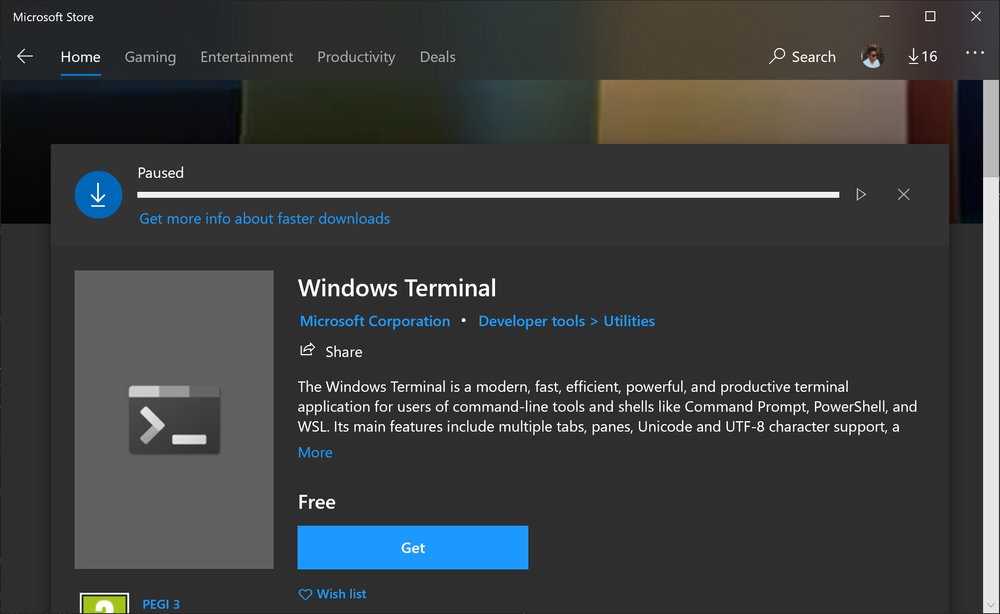
Once installed, launch the terminal. The interface is quite straightforward with tabs at the top and a dropdown menu for switching between the different profiles. By default, you get a profile for PowerShell, the Command prompt, any WSL distributions you have installed, and Microsoft Azure.
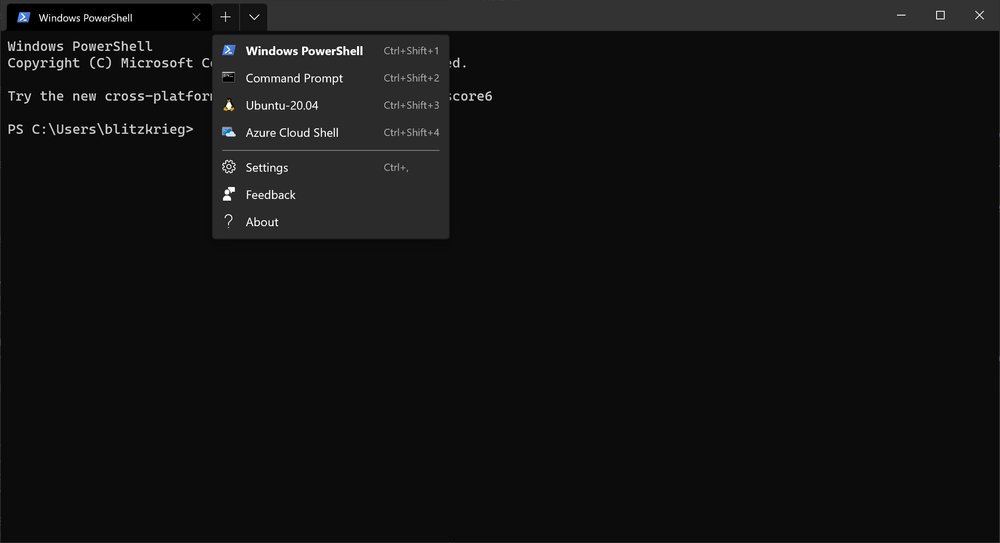
You can open the terminal settings through the dropdown menu or by pressing Ctrl + , on your keyboard. From v1.7, the JSON file that contains all the terminal settings is no longer open by default as was the case in earlier releases. A new settings UI has been developed and it’s now the default way to manage your preferences although it’s only a frontend for the underlying JSON file which can be still be accessed by pressing Ctrl + Shift + ,.
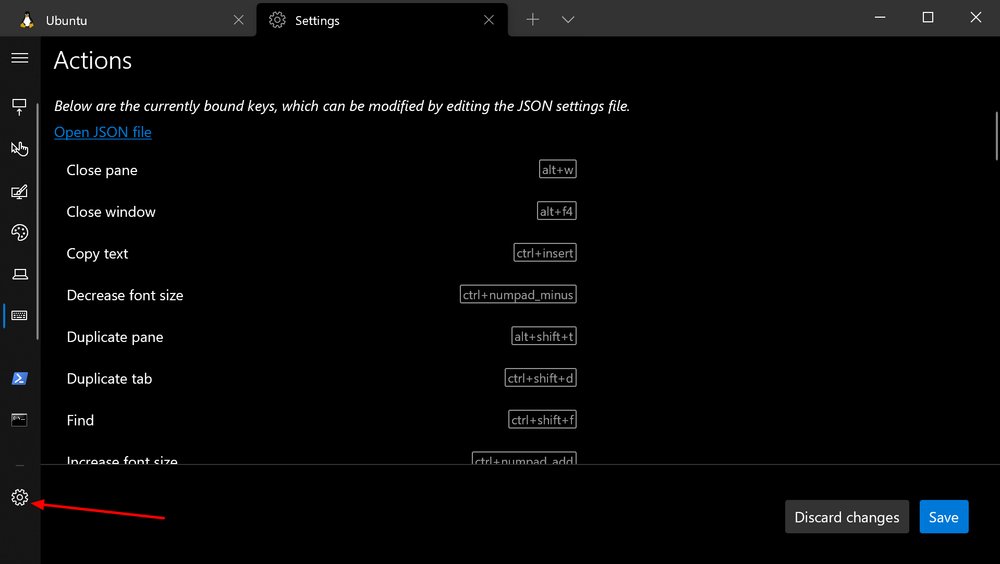
The underlying JSON configuration file can be accessed by clicking on the settings cog icon
The easiest way to bind the Windows terminal to a keyboard shortcut is to pin it to the task bar and press the Win key plus the number corresponding to the position of the program on the taskbar. For example, Win + 3 launches or focuses the terminal window on my computer.

I don’t like this method because it flashes the taskbar on the screen briefly while the switch is being made which I find distracting. Fortunately, there is a better way to do this in Windows Terminal v1.9 or later through the global summon action.
You can set it up by opening the settings JSON file with Ctrl + Shift + ,, then find the
actions property and add the following object to it:
"actions": [
{
"command": {
"action": "globalSummon"
},
"keys": "alt+t"
}
]Once that’s done, you’ll be able to bring up the Windows terminal with a keystroke. The snippet above uses Alt + t, but you can change it to your preferred key binding. Ensure to read the docs to learn how to customise it further.
You can launch the Windows Terminal from the File Explorer by typing wt and
Enter in the address bar. This will launch a new terminal window in
your default user directory. To specify the current directory instead, use wt -d ..

Additionally, you can right click on a directory in File Explorer and select “Open in Windows Terminal”. This will launch Windows Terminal with your default profile in the selected directory.

The default profile is what appears when you launch a Windows terminal instance
or open a new tab. It should be initially set to a Windows PowerShell profile but
you can easily change it to some other profile such as the one for your
preferred WSL distribution.
Achieving this can be done by updating the value of the defaultProfile
property in the settings.json file with the guid of your preferred profile.
It can also be changed through the settings UI as shown below:
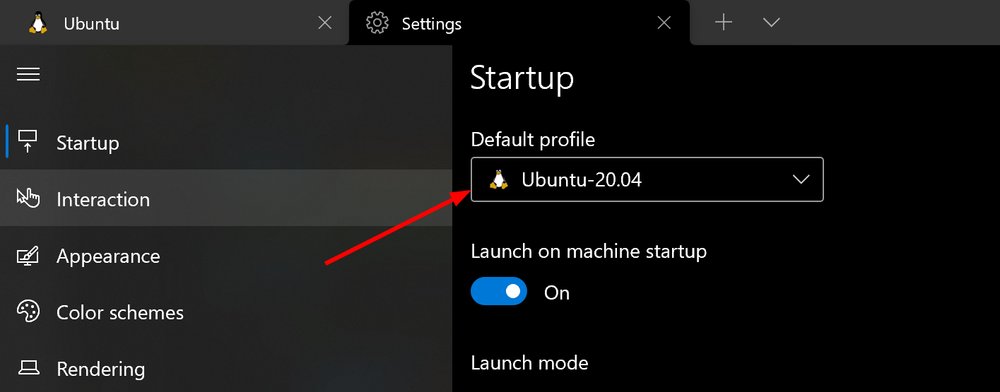
From v1.5, the Windows terminal tab switcher displays currently open tabs in
a vertical list, navigable with the keyboard or mouse. This feature had to be
activated in earlier versions by setting the useTabSwitcher property (now
deprecated) to true.

Tab switcher mode enabled in Windows Terminal v1.5 and later
You can opt out of the tab switcher experience by setting tabSwitcherMode to
false or "disabled". When the tab switcher is disabled, pressing ctrl +
tab or ctrl + shift + tab will switch tabs in a similar manner
to most web browsers. If you want to control the order of the tabs in the tab
switcher, you can set tabSwitcherMode to mru or inOrder which will list
the tabs either in most recently used order or in order of their layout in the
terminal.
// Enables the tab switcher
"tabSwitcherMode": "mru",
"tabSwitcherMode": "inOrder"
// Disables the tab switcher
"tabSwitcherMode": "disabled"
You can also search your open tabs with the tabSearch command but you have to
create a binding for it first. This is useful if you usually have several tabs
open at same time.
{
"actions": [
{ "command": "tabSearch", "keys": "ctrl+t" }
]
}The profile settings can be accessed through the profiles property in the
settings.json file. If you want any setting to apply to all profiles, add it
to the defaults property. Otherwise, add it to the relevant object in the
list array.
"defaults":
{
// SETTINGS TO APPLY TO ALL PROFILES
},
"list":
[
// PROFILE OBJECTS
]
In the settings UI, each profile has its own entry on the sidebar below the global settings.
By default, the starting directory for all shells is the Windows User directory
("%USERPROFILE%"), but you probably want this to be your Linux home directory
in your WSL profiles. You can add the startingDirectory property
to your WSL distribution
profile object as shown below to override this setting.
{
"guid": "{07b52e3e-de2c-5db4-bd2d-ba144ed6c273}",
"hidden": false,
"name": "Ubuntu-20.04",
"source": "Windows.Terminal.Wsl",
"startingDirectory": "\\\\wsl$\\Ubuntu-20.04\\home\\<username>"
}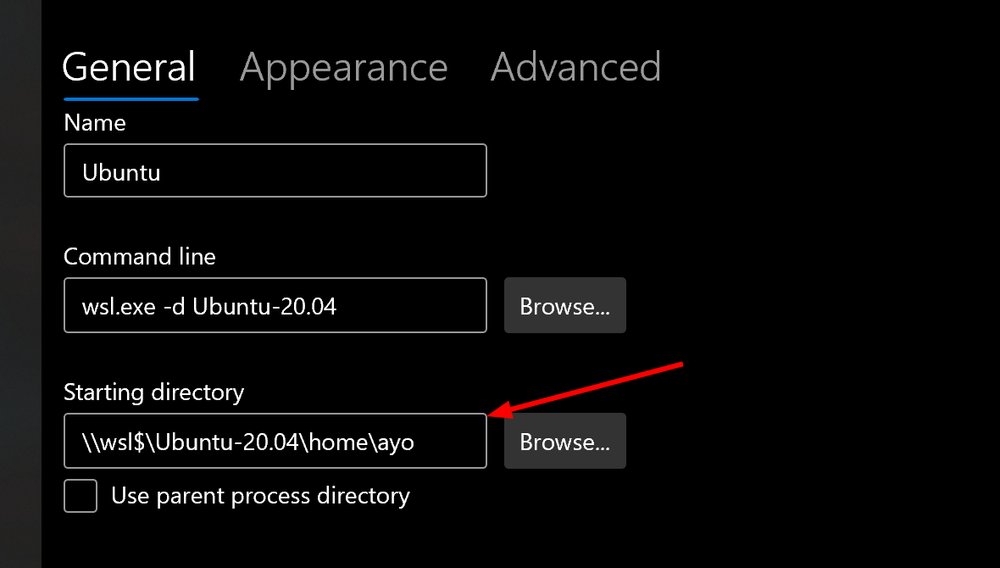
To hide a profile from the dropdown menu, set the hidden property on the
profile object to true.
{
"guid": "{b453ae62-4e3d-5e58-b989-0a998ec441b8}",
"hidden": true,
"name": "Azure Cloud Shell",
"source": "Windows.Terminal.Azure"
}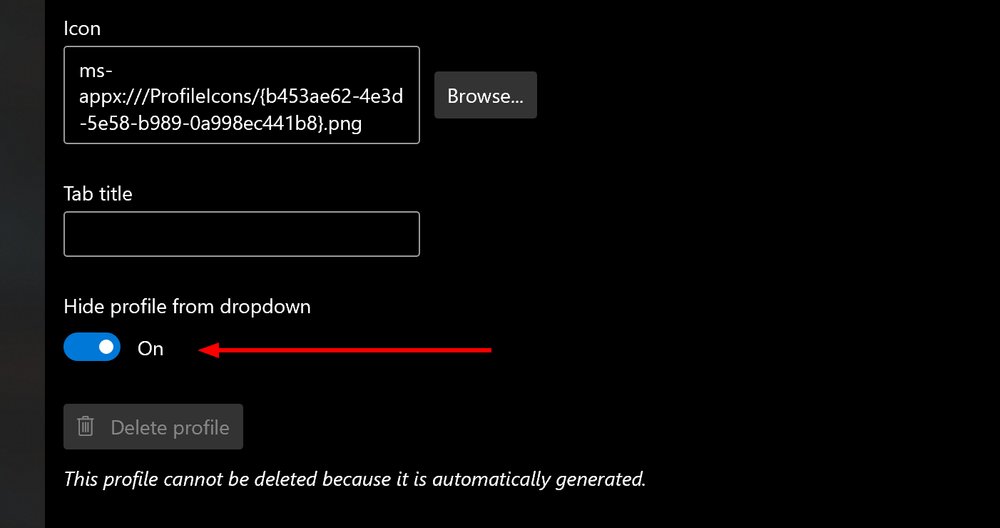
If you primarily use a terminal multiplexer like
tmux, you may want to turn off the scroll bar
for your WSL profile by setting the scrollbarState option to
hidden.
{
"guid": "{07b52e3e-de2c-5db4-bd2d-ba144ed6c273}",
"hidden": false,
"name": "Ubuntu-20.04",
"source": "Windows.Terminal.Wsl",
"startingDirectory": "\\\\wsl$\\Ubuntu-20.04\\home\\<username>",
"scrollbarState": "hidden"
}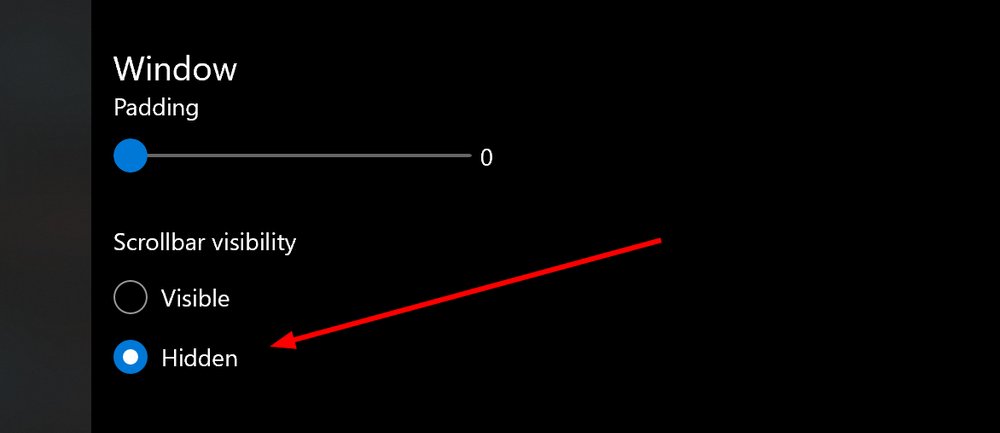
This setting can be found under the Appearance tab for the profile
You can read the documentation for the profile settings to learn about all the options available to you.
It’s possible to customise the Windows terminal with background images. The
backgroundImage property can be set to an image URL, a local file
path or the desktopWallpaper string (from v1.5), and the image in question may
be of JPEG, PNG or GIF formats. You also
have control over related settings such as opacity, alignment, and stretching.
These settings can be configured globally for all profiles or per profile.
{
"backgroundImage": "https://images.unsplash.com/photo-1554110397-9bac083977c6?ixid=MXwxMjA3fDB8MHxwaG90by1wYWdlfHx8fGVufDB8fHw%3D&ixlib=rb-1.2.1&auto=format&fit=crop&w=2100&q=80",
"backgroundImageOpacity": 0.4,
"backgroundImageAlignment": "center"
}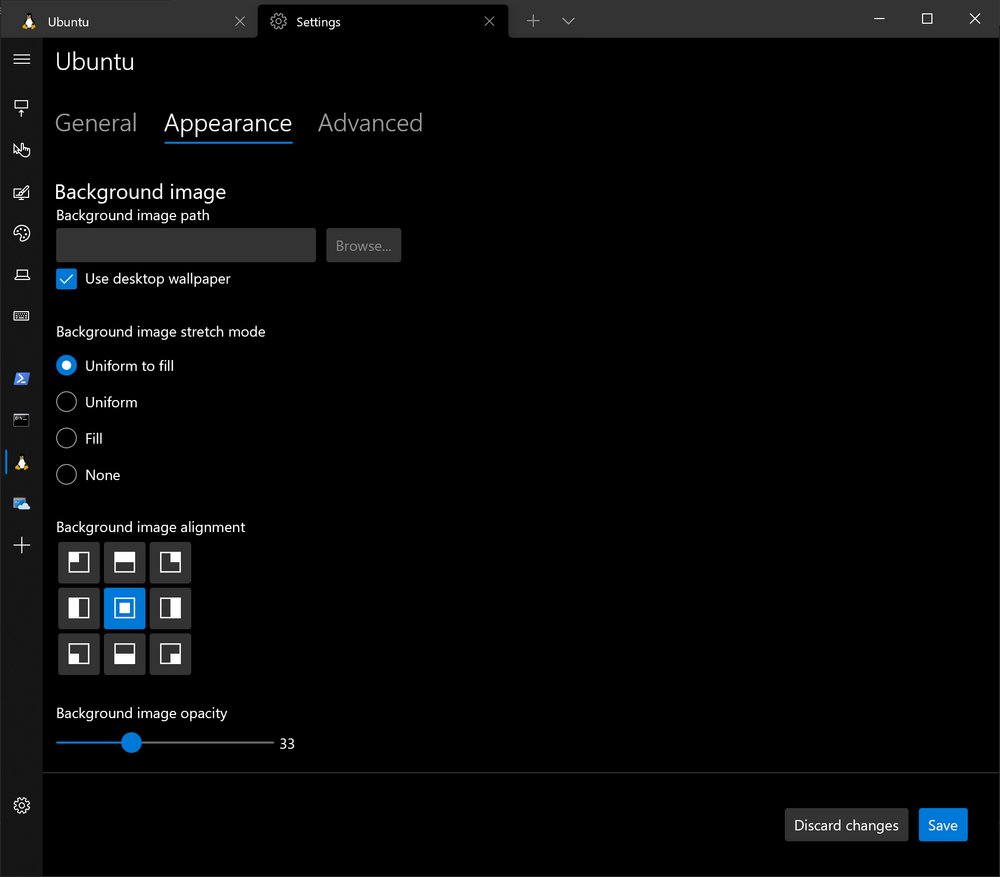

The terminal also supports the acrylic effect in Windows 10 which can be
enabled by setting useAcrylic to true. The transparency of the effect can be
controlled with acrylicOpacity (accepts a floating point between 0 and 1). You
can use these settings with or without a background image.
{
"useAcrylic": true,
"acrylicOpacity": 0.5
}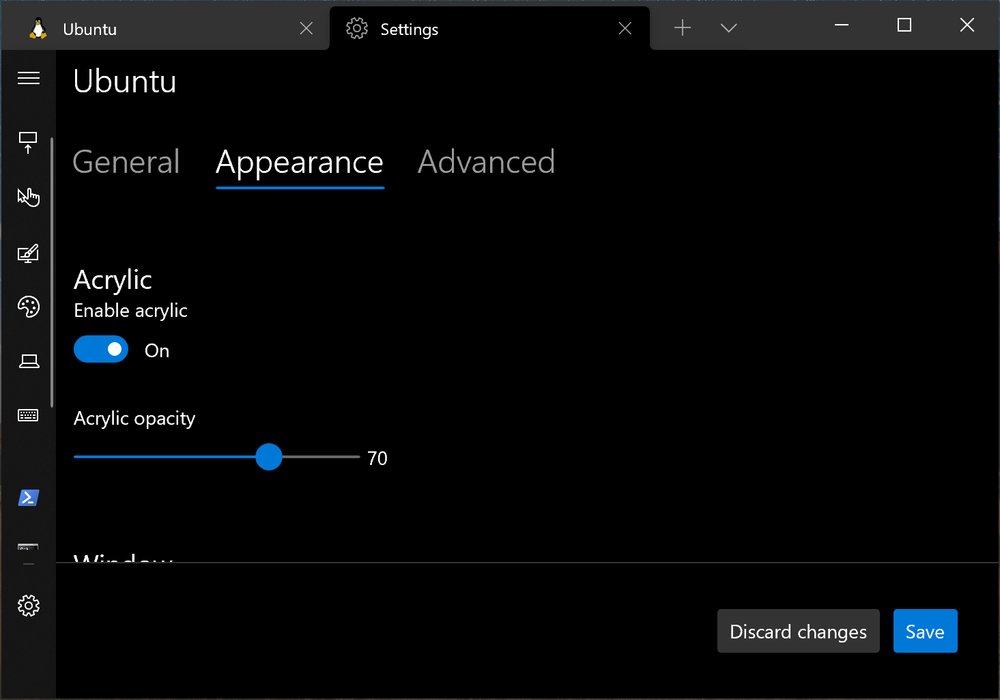

The terminal comes with a few colour schemes that you can choose from. They are accessible via the color schemes menu. You can choose your preferred global colour scheme from this menu, or add new ones if you don’t like any of the defaults.
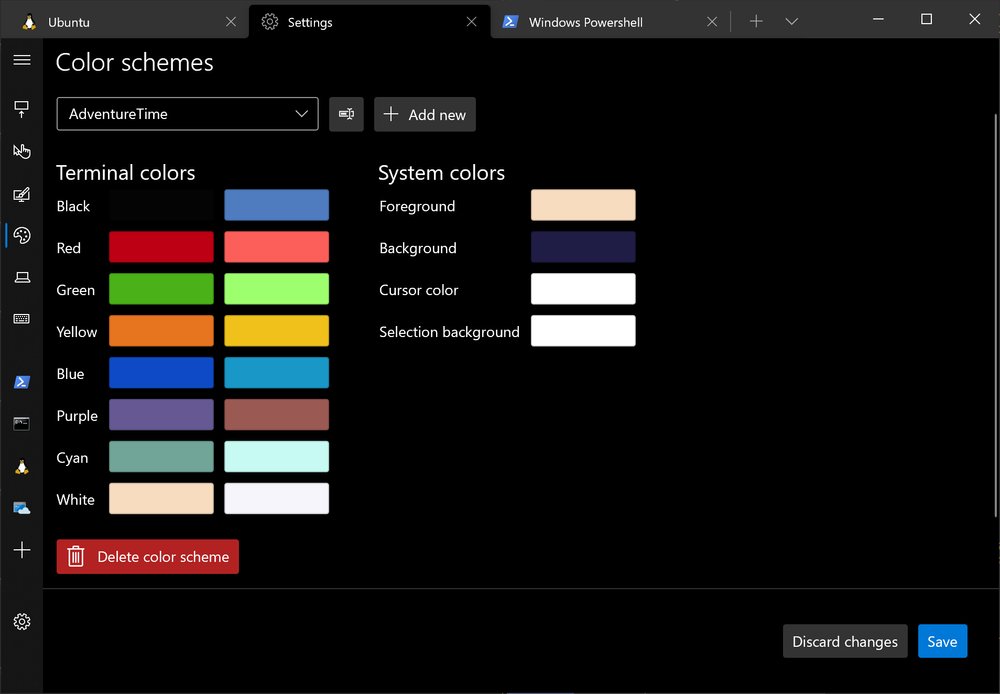
If you prefer to set a different colour scheme per profile, the relevant setting is under the Appearance tab for each profile.
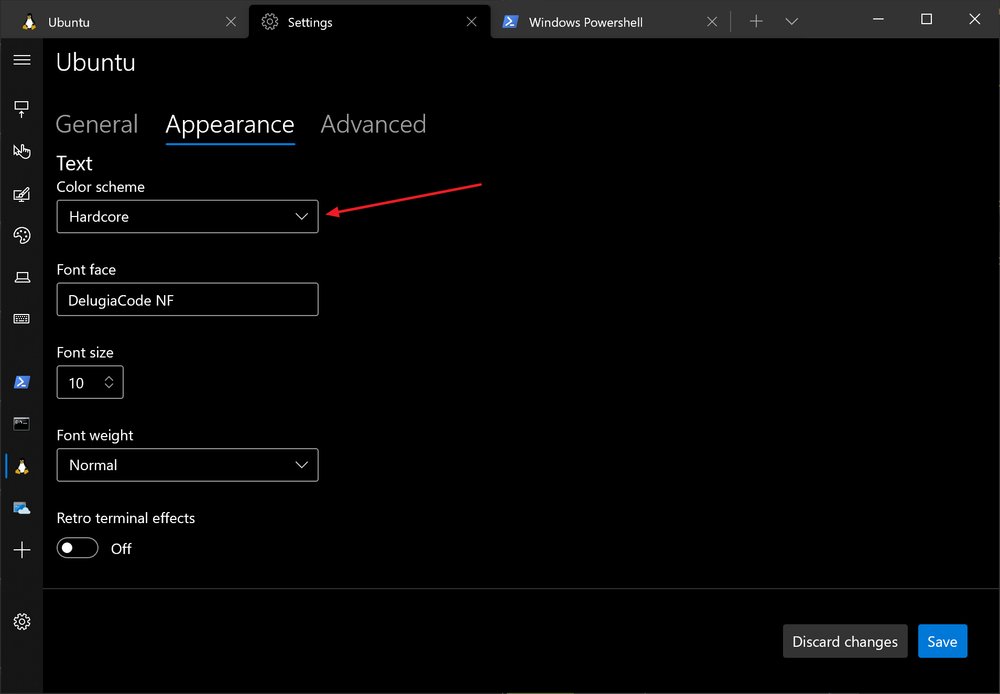
The profile colour scheme overrides the global one for the specific profile
The same can be achieved in the settings.json file through the colorScheme
option. This option can be set globally for all profiles or per profile.
{
"guid": "{61c54bbd-c2c6-5271-96e7-009a87ff44bf}",
"name": "Windows PowerShell",
"commandline": "powershell.exe",
"colorScheme": "Campbell Powershell",
"useAcrylic": true,
"acrylicOpacity": 0.9
}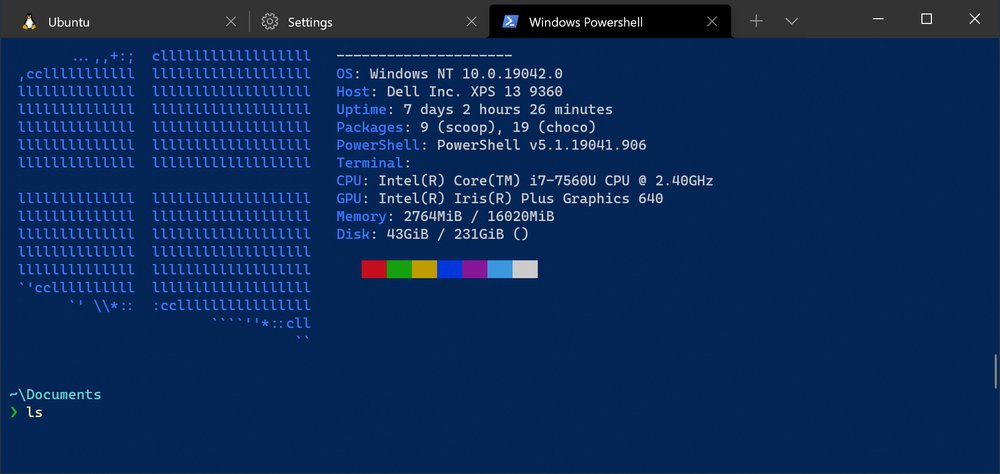
The Campbell Powershell colour scheme
Adding custom colour schemes is also easier through the settings.json file.
All you need to do is define the colour scheme object in the schemes array
section of the file. A great place to source for colour schemes is the Windows
Terminal Themes website. You can preview
each available theme and, when you find one you like, click the Get theme
button to copy its JSON object to your clipboard.

Place the JSON object in the schemes array, then set the
colorScheme property to the theme name (or use the settings UI to
set the theme). The new theme should take effect once you save the file.
{
"schemes": [
{
"name": "AdventureTime",
"black": "#050404",
"red": "#bd0013",
"green": "#4ab118",
"yellow": "#e7741e",
"blue": "#0f4ac6",
"purple": "#665993",
"cyan": "#70a598",
"white": "#f8dcc0",
"brightBlack": "#4e7cbf",
"brightRed": "#fc5f5a",
"brightGreen": "#9eff6e",
"brightYellow": "#efc11a",
"brightBlue": "#1997c6",
"brightPurple": "#9b5953",
"brightCyan": "#c8faf4",
"brightWhite": "#f6f5fb",
"background": "#1f1d45",
"foreground": "#f8dcc0"
}
]
}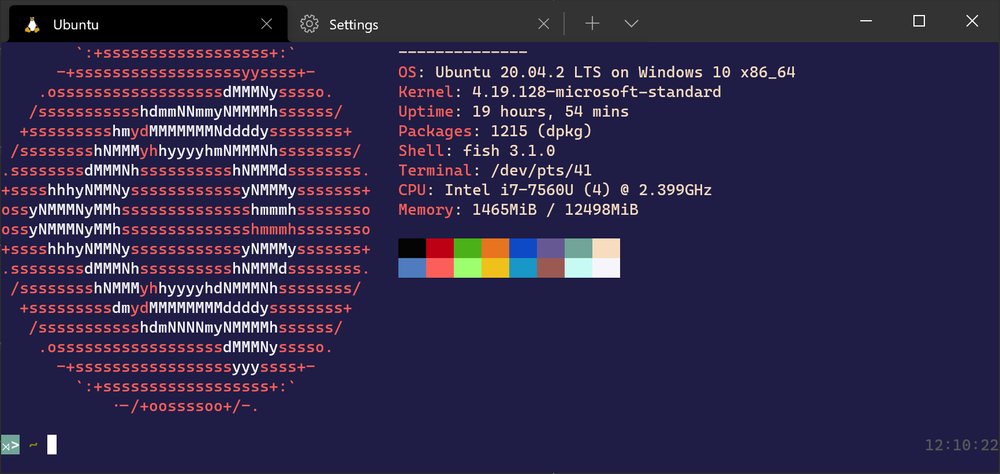
The AdventureTime colour scheme
Starship provides a customised command prompt experience that displays some handy information to give you context of what you’re doing. It supports all the popular shells on Linux, macOS, and Windows including Bash, Fish, Zsh, Powershell, and others, making it possible to get a consistent prompt even if you often switch between different shells.

This Fish prompt is styled using Starship
Before you install Starship, you need to make sure a Nerd
font is installed on your computer first to prevent
broken glyphs from ruining your prompt. A good option is Cascadia Code (the
default Windows terminal font) which can be downloaded from its GitHub releases
page. Once
downloaded, extract the zip, and install all the font files contained in the
ttf/static folder.
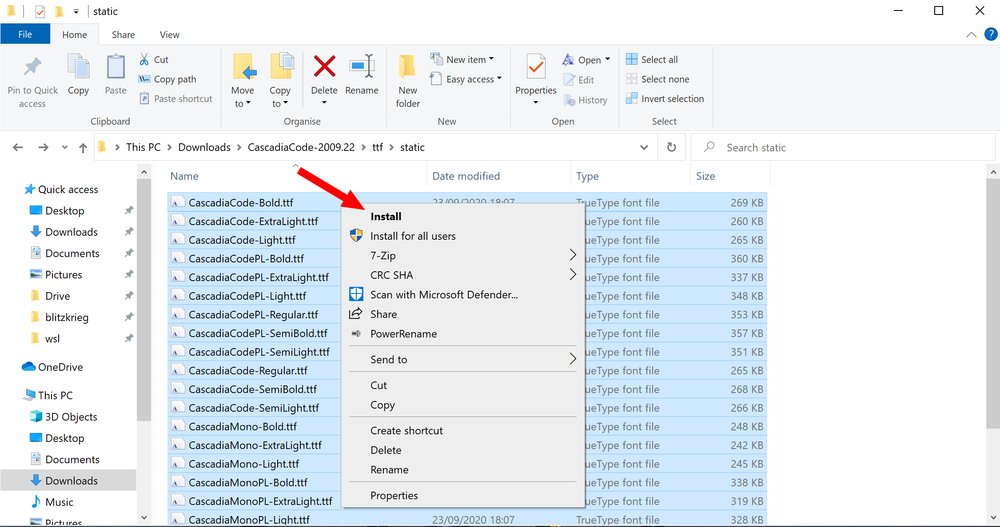
Next, change the fontFace property in your profile settings to Cascadia Code PL.
{
"fontFace": "Cascadia Code PL"
}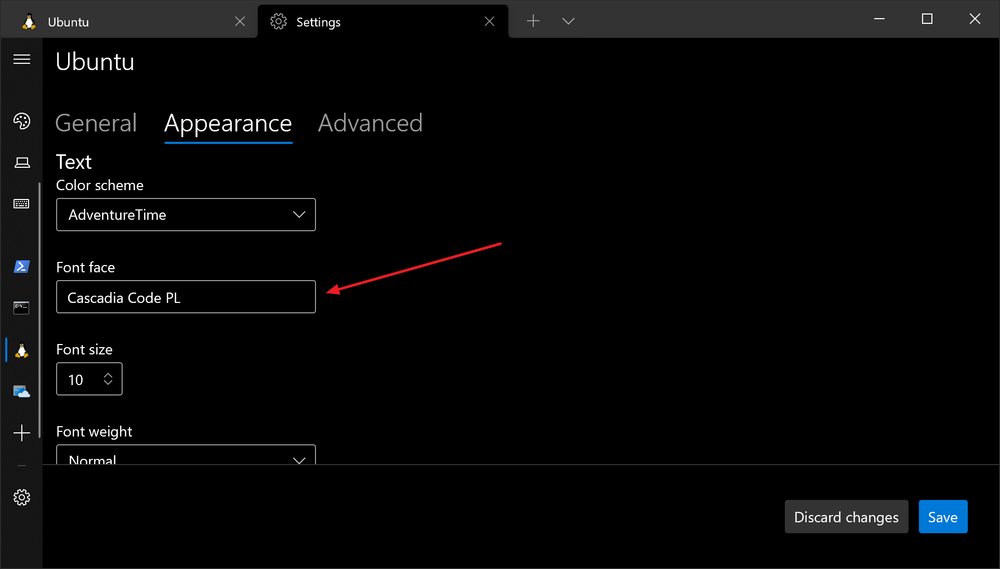
Afterwards, go ahead and install Starship by following the
instructions for your preferred shell.
Once you’re done, create a configuration file in the appropriate directory
(~/.config on Linux):
mkdir -p ~/.config && touch ~/.config/starship.tomlOpen the starship.toml file, and paste in the following contents:
add_newline = false
[character]
success_symbol = "[⚡](bold green) "
error_symbol = "[❌](bold red) "
[aws]
disabled = true
[time]
disabled = true
[cmd_duration]
disabled = true
[directory]
truncation_length = 8
[hostname]
disabled = true
[nodejs]
symbol = "🤢"
[battery]
full_symbol = "🔋 "
charging_symbol = "⚡️ "
discharging_symbol = "💀 "
disabled = false
[git_status]
conflicted = "🚩"
ahead = "💨"
behind = "😰"
diverged = "😵"
untracked = "🤷"
stashed = "📦"
modified = "📝"
staged = '[++\($count\)](green)'
renamed = "👅"
deleted = "💥"
[shell]
fish_indicator = "🦈"
bash_indicator = "🌞"
disabled = falseThe above represents my current configuration which should give you a prompt that looks similar to the previous screenshot. You can head over to the Starship docs to learn more about the available options, then tweak your configuration file as needed.
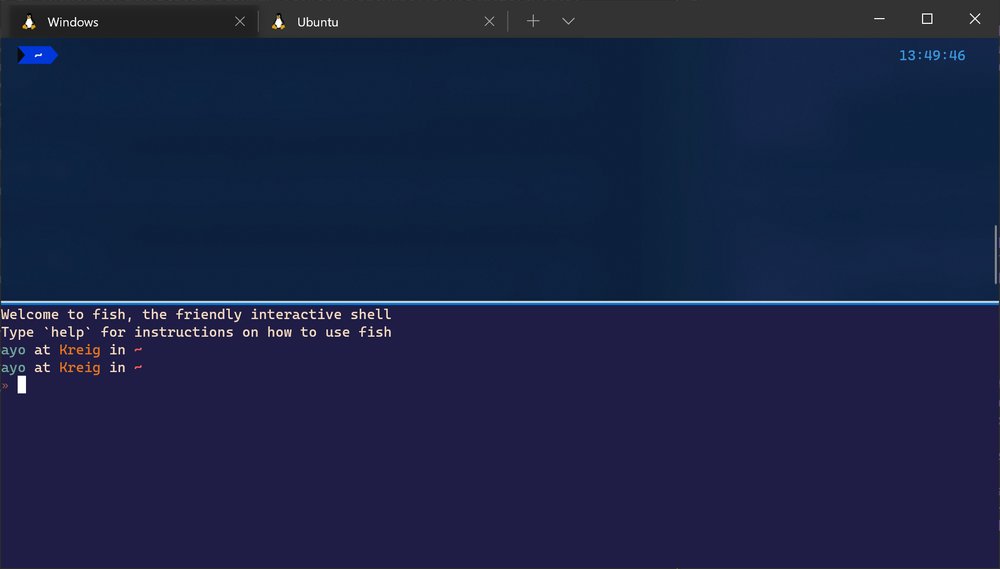
PowerShell top, Ubuntu bottom
The Windows terminal supports splitting a tab into multiple panes. This makes it
easy to multitask without having to switch tabs. I use tmux for this purpose
in WSL so it’s not something I rely on often, but it’s handy to
have especially if you need to work in PowerShell or cmd.exe for example.
The default shortcuts to split a pane horizontally and vertically are Alt + Shift + - and Alt + Shift + = respectively. You can also split a pane using the command palette which can be accessed with Ctrl + Shift + p:

If you hold down the Alt key and press the new tab button on one of the profiles in the terminal dropdown menu, it would also auto split the active window or pane. To switch focus between panes, hold down Alt and use your arrow keys or click on the desired pane. Resizing the focused pane is done by holding down Alt + Shift and one of the arrow keys. Closing a pane can be done with Ctrl + Shift + W.
All the hotkeys for Windows Terminal commands can be customised through the
actions property (formerly keybindings) in the settings.json file. If you
inspect the defaults.json file for your terminal (by holding the Alt
key while clicking the Settings menu), you’ll see all the default key bindings
organised in several categories in the root level actions array.
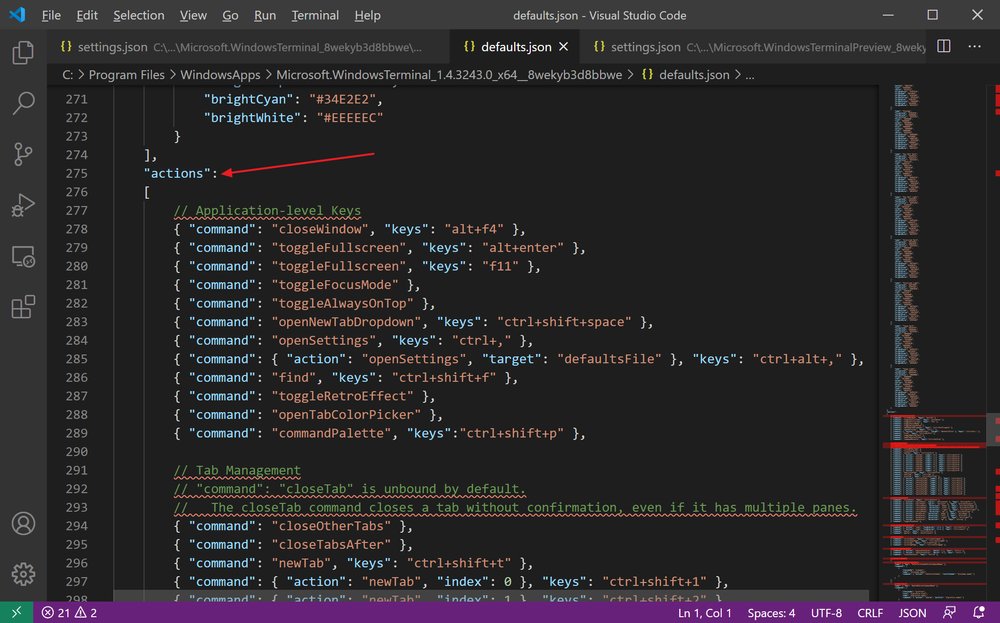
You can add a new hotkey for an action by copying the relevant binding object
from the defaults.json file to the settings.json file, and changing the
keys property in the object. If you modify the defaults.json file directly,
your changes will be lost when the program updates. For example, the bindings
for splitting panes can be customised as shown below:
{
"actions": [
{ "command": { "action": "splitPane", "split": "vertical" }, "keys": "alt+v" },
{ "command": { "action": "splitPane", "split": "horizontal" }, "keys": "alt+h" }
]
}The above lines add new bindings for the splitPane action, but the original
bindings will remain active. To remove a default key binding, assign the key to
the unbound command as shown below:
{
"actions": [
{ "command": { "action": "splitPane", "split": "vertical" }, "keys": "alt+v" },
{ "command": { "action": "splitPane", "split": "horizontal" }, "keys": "alt+h" },
{ "command": "unbound", "keys": "alt+shift+-" },
{ "command": "unbound", "keys": "alt+shift+=" }
]
}Windows terminal also gives you the ability to send input commands to your shell with a key stroke. This is handy for commonly used commands. Here’s an example that binds Alt + G to sending a command that navigates to the root of the working tree in a git repo:
{
"actions": [
{ "command": {"action": "sendInput", "input": "cd (git rev-parse --show-toplevel)"}, "keys": "alt+g" }
]
}The full list of commands and their options can be found in the actions documentation.
It can be handy to automatically SSH into remote machines through the Windows Terminal. This can be done by setting up a new custom profile per machine.
{
"guid": "{4b8d0cfe-e8be-4ae6-a4ad-88efd65b0880}",
"hidden": false,
"name": "Failed Experiments",
"commandline": "wsl ssh user@localhost",
"icon": "🤡"
}The guid field must be unique amongst the profiles. You can make changes to an
exisiting one or generate it online. Regarding
the icon, you can use an emoji character (v1.5 or later) or type the path to a
suitable image file. Once you save the settings file, you should see your new
entry similar to the screenshot below.
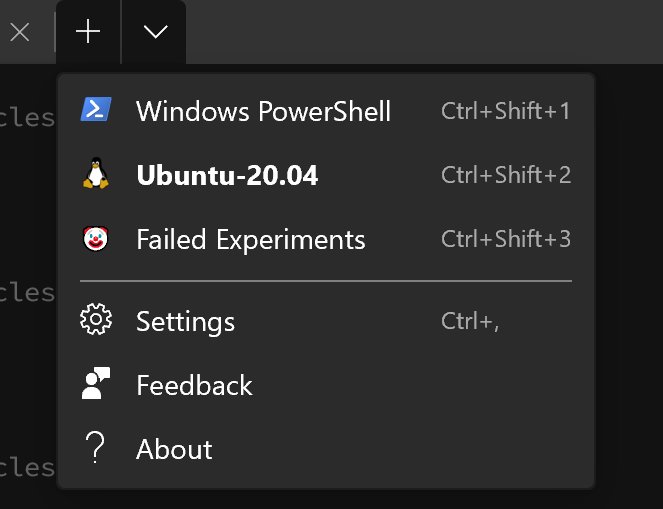
Once you click the entry, it will automatically connect to the remote server in your preferred Linux distribution.
Windows terminal launches with a single tab and a single pane using your default profile, but you can customise this behaviour through command line arguments. Here’s an example that launches the terminal with a custom layout of three split panes in a single tab. The panes are running a WSL profile, a PowerShell profile, and a Command Prompt profile respectively.
wt; split-pane -p "Windows PowerShell"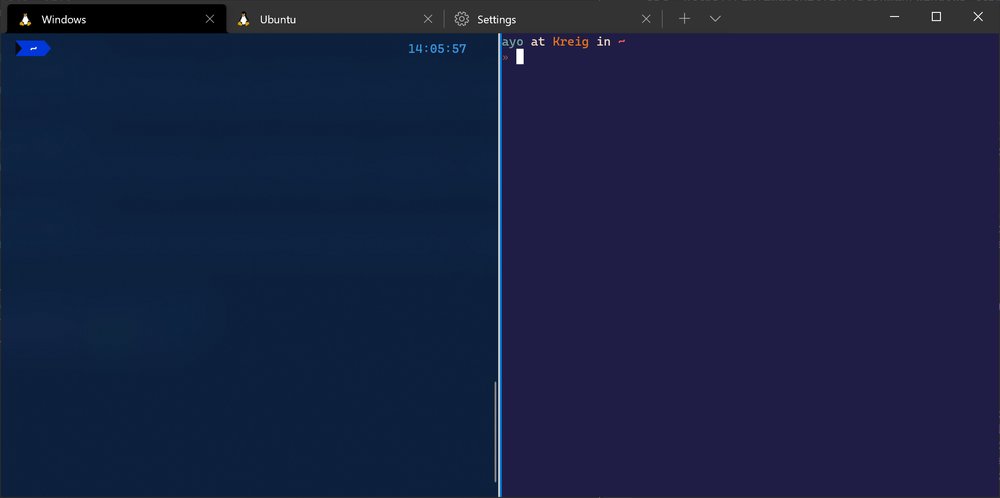
Here’s a breakdown of the above command:
wt on its own launches a new window with a single tab and a single pane
with the default profile. Each command after wt must be separated with a
semicolon.split-pane splits the current pane into two defaulting to auto if you
don’t specify a direction (-H or -V). The -p flag allows you to specify
the the type of profile you want to open by name or guid.After you have defined your preferred startup layout, you can bind it to a hotkey using AutoHotkey or create a new Windows shortcut and pin it to your desktop or taskbar.
In this post, we discussed several ways to customise the Windows Terminal. I hope it has helped you improve your workflow and productivity on the command line. If you have any more tips, please share them in the comments section below.
Thanks for reading, and happy coding!
Comments
Ground rules
Please keep your comments relevant to the topic, and respectful. I reserve the right to delete any comments that violate this rule. Feel free to request clarification, ask questions or submit feedback.